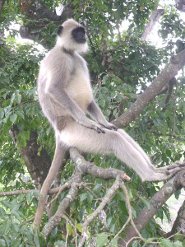 The Hanuman langur (Semnopithecus entellus) is a native of South Asia. The monkey got its name from a Hindu god and is considered sacred. Legend says the monkey god, Hanuman, burned down a town to save a woman and was consequently ensared in the blaze. The black face and hands of the langur are thought to represent Hanuman’s burns.
The Hanuman langur (Semnopithecus entellus) is a native of South Asia. The monkey got its name from a Hindu god and is considered sacred. Legend says the monkey god, Hanuman, burned down a town to save a woman and was consequently ensared in the blaze. The black face and hands of the langur are thought to represent Hanuman’s burns.The langur is mostly gray with some silver or beige shading. Some langurs may be brown. The males measure up to 75 cm (2.4 ft), and females measure up to 65 cm (2.1 ft). Their snakelike tales can reach as long as 101 cm (3.3 ft). The male weighs around 18 kg (39.6 lbs), while the female weighs around 11 kg (24.2 lbs). Northern langurs are generally bigger than the southern species.
Langurs are widespread across the Indian subcontinent. They have a large span of habitats, from the plains to the rainforest. Excluding humans, langurs have the widest habitat range of any primate. Many are found in urban areas as well.
Their diet is vast and changes with the seasons. During the colder season, they eat matured leaves. In the warmer weather, their diet consists of fruits, bark, and tree gum. They also eat insects, nuts, and seeds. Langurs can digest things that other creatures can’t, like stones.
Hanuman langurs walk on all fours.
The langur is considered endangered. The most common threats are tigers, panthers, and loss of habitat. Because langurs ransack urban food supplies, humans are a threat factor. Despite the possible risk of human retaliation, Hanuman langurs are revered by many because of their unique qualities and history.
Picture of the hanuman langur by marcus334, licensed under Creative Commons Attribution-Share Alike 3.0 Unported license
Keywords: gray
The Common langur, entellus langur, grey langur, hanuman langur, true langur is listed as Near Threatened (LR/nt), is close to qualifying for or is likely to qualify for a threatened category in the near future, on the IUCN Red List of Threatened Species
Hanuman langur habitats
Forest, Shrubland, Subtropical / Tropical Dry forest and Subtropical / Tropical Dry ShrublandSome facts about the
Hanuman langur
Adult weight : 13.517 kg (29.7374 lbs)
Maximum longevity : 29 years
Female maturity :1162 days
Male maturity : 1886 days
Gestation : 192 days
Weaning : 342 days
Litter size : 1
Litters per year : 1
Interval between litters : 514 days
Weight at birth : 0.5 kg (1.1 lbs)
Weight at weaning : 2.1 kg (4.62 lbs)

Custom Search